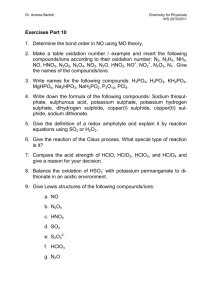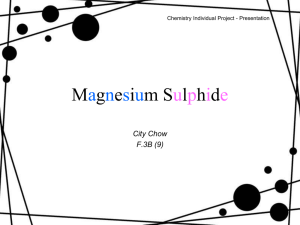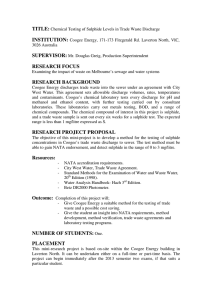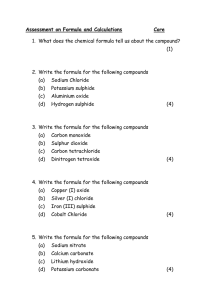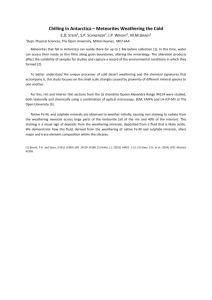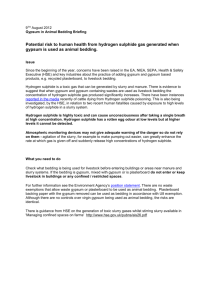Nephtys hombergii , a free-living predator in marine sediments:
advertisement
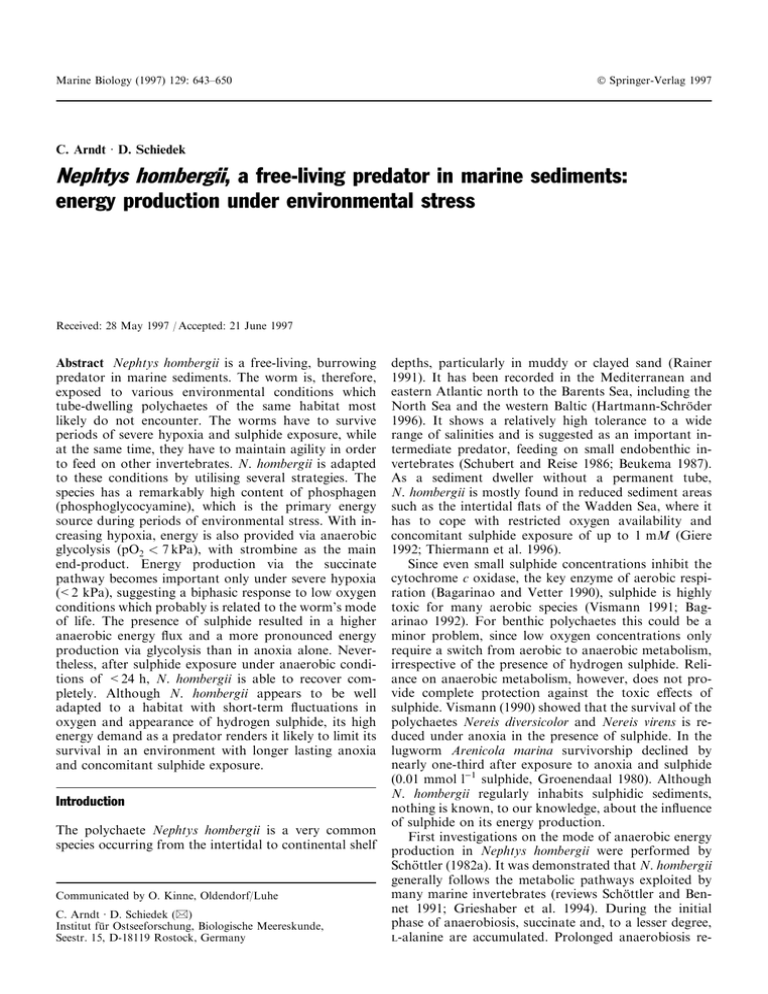
Marine Biology (1997) 129: 643±650 Ó Springer-Verlag 1997 C. Arndt á D. Schiedek Nephtys hombergii, a free-living predator in marine sediments: energy production under environmental stress Received: 28 May 1997 / Accepted: 21 June 1997 Abstract Nephtys hombergii is a free-living, burrowing predator in marine sediments. The worm is, therefore, exposed to various environmental conditions which tube-dwelling polychaetes of the same habitat most likely do not encounter. The worms have to survive periods of severe hypoxia and sulphide exposure, while at the same time, they have to maintain agility in order to feed on other invertebrates. N. hombergii is adapted to these conditions by utilising several strategies. The species has a remarkably high content of phosphagen (phosphoglycocyamine), which is the primary energy source during periods of environmental stress. With increasing hypoxia, energy is also provided via anaerobic glycolysis (pO2 < 7 kPa), with strombine as the main end-product. Energy production via the succinate pathway becomes important only under severe hypoxia (<2 kPa), suggesting a biphasic response to low oxygen conditions which probably is related to the worm's mode of life. The presence of sulphide resulted in a higher anaerobic energy ¯ux and a more pronounced energy production via glycolysis than in anoxia alone. Nevertheless, after sulphide exposure under anaerobic conditions of <24 h, N. hombergii is able to recover completely. Although N. hombergii appears to be well adapted to a habitat with short-term ¯uctuations in oxygen and appearance of hydrogen sulphide, its high energy demand as a predator renders it likely to limit its survival in an environment with longer lasting anoxia and concomitant sulphide exposure. Introduction The polychaete Nephtys hombergii is a very common species occurring from the intertidal to continental shelf Communicated by O. Kinne, Oldendorf/Luhe C. Arndt á D. Schiedek (&) Institut fuÈr Ostseeforschung, Biologische Meereskunde, Seestr. 15, D-18119 Rostock, Germany depths, particularly in muddy or clayed sand (Rainer 1991). It has been recorded in the Mediterranean and eastern Atlantic north to the Barents Sea, including the North Sea and the western Baltic (Hartmann-SchroÈder 1996). It shows a relatively high tolerance to a wide range of salinities and is suggested as an important intermediate predator, feeding on small endobenthic invertebrates (Schubert and Reise 1986; Beukema 1987). As a sediment dweller without a permanent tube, N. hombergii is mostly found in reduced sediment areas such as the intertidal ¯ats of the Wadden Sea, where it has to cope with restricted oxygen availability and concomitant sulphide exposure of up to 1 mM (Giere 1992; Thiermann et al. 1996). Since even small sulphide concentrations inhibit the cytochrome c oxidase, the key enzyme of aerobic respiration (Bagarinao and Vetter 1990), sulphide is highly toxic for many aerobic species (Vismann 1991; Bagarinao 1992). For benthic polychaetes this could be a minor problem, since low oxygen concentrations only require a switch from aerobic to anaerobic metabolism, irrespective of the presence of hydrogen sulphide. Reliance on anaerobic metabolism, however, does not provide complete protection against the toxic eects of sulphide. Vismann (1990) showed that the survival of the polychaetes Nereis diversicolor and Nereis virens is reduced under anoxia in the presence of sulphide. In the lugworm Arenicola marina survivorship declined by nearly one-third after exposure to anoxia and sulphide (0.01 mmol l)1 sulphide, Groenendaal 1980). Although N. hombergii regularly inhabits sulphidic sediments, nothing is known, to our knowledge, about the in¯uence of sulphide on its energy production. First investigations on the mode of anaerobic energy production in Nephtys hombergii were performed by SchoÈttler (1982a). It was demonstrated that N. hombergii generally follows the metabolic pathways exploited by many marine invertebrates (reviews SchoÈttler and Bennet 1991; Grieshaber et al. 1994). During the initial phase of anaerobiosis, succinate and, to a lesser degree, L-alanine are accumulated. Prolonged anaerobiosis re- 644 sults in the formation of the short-chain fatty acids acetate and propionate which are mostly excreted into the water. Although N. hombergii has a high glycolytic capacity, no lactate dehydrogenase was detected. Instead, strombine and alanopine dehydrogenases were present in comparatively high activities (SchoÈttler 1982a). These opine dehydrogenases are known from many marine invertebrates (Grieshaber and Kreutzer 1986) for catalysing the reduction of pyruvate to either strombine (cosubstrate glycine) or alanopine (co-substrate alanine). However, it remains unsolved which opine is accumulated as the end-product of glycolysis. Furthermore, information is lacking about the importance of phosphagen as an energy source. In order to understand the strategies used by Nephtys hombergii to cope with dierent kinds of environmental stress, we performed experiments under various simulated in situ conditions. The main emphasis was to specify (1) the energy source used for short-term energy production, (2) the in¯uence of hydrogen sulphide on the mode of anaerobic energy production and (3) the worm's ability to recover from anoxic sulphide treatment. Materials and methods Collection and maintenance Specimens of Nephtys hombergii were collected from the tidal ¯ats of KoÈnigshafen (Sylt, Germany) during periods of low tide. The worms were kept in well-aerated arti®cial sea water (29& S, 12 °C) in tanks containing a 2 cm layer of sand. Individuals were adapted to these conditions for a minimum of 5 d prior to their use in the experiments. Experimental procedure All experiments were performed at 12 °C. Immediately after the experiments, the worms were rapidly blotted dry, dropped into liquid nitrogen and stored at )70 °C until tissue extraction. Hypoxia To simulate environmental hypoxia, ten specimens of Nephtys hombergii were incubated in round ¯asks containing 450 ml arti®cial sea water (29& S) at various oxygen pressures (pO2). The worms were kept under these conditions for a period of 24 h. Dierent pO2 were obtained by equilibrating the water in the incubation ¯asks with a mixture of pure nitrogen and oxygen (AGA, Germany), delivered by a gas mixing pump (M 200a, WoÈstho, Bochum, Germany). In order to maintain a stable oxygen partial pressure, the ¯asks were bubbled constantly during the incubations. Anoxia in the presence and absence of sulphide In order to study the in¯uence of sulphide on the anaerobic energy production, specimens of Nephtys hombergii (North Sea, 29& S) were exposed to anoxia and dierent sulphide concentrations (0.1 and 1 mmol l)1). Round ¯asks were used in the experiments which were equipped with special ®ttings for gassing (SchoÈttler and Schro 1976) . The ¯asks were ®lled with 450 ml of arti®cial sea water (29& S, 12 °C) and a thin layer of ®ne sand. Anoxia was achieved by bubbling the ¯asks with pure nitrogen (AGA, Germany) for 60 min. At the beginning of an experiment, ten individuals of Nephtys hombergii were placed into each ¯ask. Gassing was continued for 5 min before the stop-cocks were closed. In a parallel set of experiments, sulphide stock solution was added to the ¯asks to reach a ®nal concentration of 0.1 or 1 mmol l)1 sulphide. Sulphide concentrations of the incubation media were measured at the beginning and the end of each experimental run (3, 6, or 24 h). Recovery from sulphide treatment After 24 h anoxic incubation in the absence or presence of hydrogen sulphide (1 mmol l)1), the worms were transferred into small tanks (ten worms in each), which contained well-aerated sea water (29& S, 12 °C). After dierent periods of time (0, 0.5, 1, 3, 6, 24 and 48 h), specimens were removed from a tank and prepared for further analysis as described above. Muscular activity In order to achieve increased muscular activity as it would occur during extensive burrowing, worms were placed individually into small tanks with sea water (29& S), connected by electrodes. Electrical impulses (3.5 to 8.0 V, AC) evoked contraction of the whole worms. Stimulation was continued until the worms were exhausted and ceased responding. Determination of anaerobic end-products The frozen tissues were extracted as described by Schiedek and SchoÈttler (1990). Succinate concentration was estimated according to Michal et al. (1976). Strombine and alanopine levels were determined by HPLC (VoÈlkel et al. 1995). Short-chain fatty acids were measured after steam destillation of the incubation water by gas chromatography (Kluytmans et al. 1975). The separation and determination of the most important free amino acids was performed via HPLC (Schiedek 1997). Phosphoglycocyamine was measured with a test similar to the phosphotaurocyamine assay described in PoÈrtner et al. (1979). The glycocyamine kinase, used in the test, was puri®ed from the body wall of Nereis virens after SchoÈttler (1982b). The presence of further phosphagens was tested (phosphocreatine, phosphotaurocyamine and phospho-L-arginine) using the respective kinases. Measurement of glycogen was employed after SchoÈttler et al. (1990). Preparation of sulphide stock solutions Stock solutions of hydrogen sulphide were prepared by dissolving washed crystals of Na2S ´ H2O (7 to 9 molecules H2O per mole NaS) in N2-saturated sea water (29& S). Immediately before use in the experiments, the concentration of the stock was determined by an iodometric titration (Poethke 1973). Determination of sulphide concentrations The sulphide concentration in the incubation water was determined spectrophotometrically at 670 nm, using the methylene blue method (Gilboa-Garber 1971). The term ``sulphide'', as used in the context of the present study, is intended to include H2S, HS) and S2). Data analysis All metabolite concentrations are given as mean values SD. Signi®cance between anoxic and sulphide treatments was determined after Welch (Sachs 1988) at the p 0:05 level. 645 Results Hypoxia Phosphoglycocyamine was the only phosphagen present in Nephtys hombergii. Under normoxic conditions it could be measured in concentrations of about 160 lmol g)1 dry wt. With decreasing oxygen concentrations it was degraded rapidly (Table 1). However, even under anoxic conditions, it was only depleted by about 60%. Anaerobic energy production via glycolysis, as evident from the production of strombine, started at a pO2 of about 3.4 kPa and ®nally reached about 17 lmol g)1 dry wt. Alanopine was only found in concentrations <1 lmol g)1 dry wt. The accumulation of the amino acid alanine as well as the decrease of the aspartate pools also started at a pO2 of about 3.4 kPa. Succinate, an indicator for the propionate pathway, ®rst appeared at a pO2 of 1.7 kPa. Its production was more pronounced (20 lmol g)1 dry wt) at very low oxygen concentrations. Under these conditions, the short-chain fatty acids acetate and propionate also reached their highest levels (17 lmol g)1 dry wt and 27 lmol g)1 dry wt, respectively). Tolerance to anoxia and sulphide After onset of anoxia, about 100 lmol g)1 dry wt phosphoglycocyamine were used within the ®rst 3 h. Thereafter, no further reduction was recorded (Fig. 1). The presence of sulphide (up to 1 mmol l)1) caused no signi®cant dierence in the utilisation of the phosphagen. Strombine, the end-product of anaerobic glycolysis, accumulated from the beginning of anaerobiosis. The extent of accumulation was dependent on the sulphide concentration. Higher sulphide concentrations resulted in a clearly higher strombine accumulation (Fig. 2). Furthermore, alanopine reached concentrations up to 8 lmol g)1 dry wt in the presence of sulphide. The production of succinate was somewhat enhanced during the ®rst 6 h of anoxia in the presence of sulphide, while the accumulation and excretion of propionate was similar in both types of incubations (Fig. 2). The ®nal succinate concentration (after 24 h) appeared to be lower in the presence of sulphide compared to anoxia Fig. 1 Nephtys hombergii. Phosphoglycocyamine content (lmol g)1 dry wt) after anoxic incubation (0 to 24 h) in absence and presence of sulphide (1 mmol 1)1). Mean SD, n 3 alone. A relationship between sulphide concentration and succinate/propionate production was not apparent. Glycogen was stored at a concentration of about 120 lmol g)1 dry wt. Within 24 h of anoxia it was markedly degraded (Table 2). The presence of sulphide had no signi®cant eect on the degradation of glycogen. Recovery after exposure to anoxia and sulphide The recovery from anoxic incubation in the absence or presence of sulphide (1 mmol l)1) is re¯ected in the concentration changes of phosphoglycocyamine, succinate, alanopine and strombine. Most of the phosphoglycocyamine, depleted during anaerobiosis, was replenished within the ®rst 3 h (Fig. 3a), while after sulphide exposure about 6 h were needed for its recovery. The accumulated succinate was metabolised immediately after the onset of aerobic conditions. About half of it disappeared within the ®rst hour (anoxia) or 3 h (sulphide), respectively. The concentration of alanopine remained high for 6 h (anoxia). After exposure to sulphide, the alanopine concentration was signi®cantly higher and oxidation started sooner after the onset of aerobic conditions (Fig. 3b). Within 1 h it had reached the same level as in the anoxic incubation without sulphide. The accumulation of strombine was nearly 50% Table 1 Nephtys hombergii. Content of various metabolites (lmol g)1 dry wt) after incubation (24 h) at dierent pO2. Mean SD, n 4 pO2 (kPa) P-glycocyamine Strombine Aspartate Alanine Succinate Propionate Acetate 18 13.8 6.9 3.4 1.7 0.86 0 158 142 167 131 109 73 67 <0.5 0.9 1.0 6.9 16.1 15.6 17.2 35 32 31 30 21 17 14 26 27 31 34 33 43 42 <0.5 <0.5 <0.5 <0.5 8.7 0.7 17.1 2.7 20.3 2.3 0.7 0.6 0.5 1.6 4.5 6.2 17.2 1.9 3.2 3.2 11.4 10.4 16.8 27.4 16 24 15 18 16 9 29 0.1 0.1 2.7 5.0 4.4 2.5 7 4 4 1 2 3 3 4 4 7 5 9 9 5 0.1 0.1 0.2 0.2 1.3 1.2 2.9 0.2 0.2 0.3 6.0 5.1 6.6 4.1 646 higher in the presence of sulphide. During recovery its concentration declined within the ®rst 6 h to about 15 lmol g)1 dry wt. Similar concentrations as in the controls were ®nally reached after 48 h. In absence of sulphide, no decrease in the strombine concentration was detectable within the ®rst 6 h of recovery. Nevertheless, after 24 h the concentration was nearly as low as in the controls. Enhanced muscle activity When the worms were stressed to exhaustion, about onethird (40 lmol g)1 dry wt) of the phosphoglycocyamine was used (Table 3). Strombine and alanopine accumulated under these conditions to about 23 lmol g)1 dry wt and 4 lmol g)1 dry wt, respectively. Table 2 Nepthys hombergii. Glycogen content (lmol glycosyl units g)1 dry wt) after anoxic incubation in absence and presence of sulphide (1 mmol l)1). Mean SD, n 6 Incubation time (h) Anoxia Anoxia/H2S 0 6 24 117 39 82 14 27 7 117 39 90 22 17 6 Fig. 2 Nephtys hombergii. Content of various metabolites (lmol g)1 dry wt) after anoxic incubation (0 to 24 h) in absence and presence of sulphide (0.1 or 1 mmol l)1). Mean SD, n 3 Discussion Due to its predatory life habit, free-living in the sediments, the polychaete Nephtys hombergii is exposed to more adverse environmental conditions than tubedwelling species in the same environment. It has to provide energy to burrow and hunt, even under frequently anaerobic conditions, and even in the presence of the respiratory inhibitor sulphide. The importance of phosphagens for immediate energy provision has been demonstrated for many marine invertebrates (Florkin and Scheer 1979), and dierences in the type of phosphagen used have become obvious. Phosphoglycocyamine, as it was found in Nephtys hombergii, is also characteristic for Scoloplos armiger (SchoÈttler and Grieshaber 1988) and for polychaetes of the families Nereidae and Aphroditidae (Florkin and Scheer 1979). However, phosphagen concentrations as high as in N. hombergii have not been measured before in any other marine polychaete (Table 4). Comparably high concentrations have been detected only in the tail muscle of the shrimp Crangon crangon. This body part is specialised in performing maximal work during only one or 647 Fig. 3 Nephtys hombergii. Content of a phosphoglycocyamine (PGC ) and succcinate (lmol g)1 dry wt) and b alanopine and strombine (lmol g)1 dry wt) during aerobic recovery after anoxic incubation (24 h) in absence (open symbols) and presence (closed symbols) of sulphide (1 mmol l)1). Mean SD, n 3 (Con aerobic controls) 648 two contractions, resulting in a nearly total depletion of the phosphagen (Onnen and Zebe 1983). N. hombergii, in contrast, reduced its phosphagen stores only to one-third during burst activity, although this worm also has to perform quick movements when burrowing through the sediment. Only the additional exposure to anoxia before performing enhanced muscular work, leads to a further depletion of the phosphoglycocyamine (Schiedek unpublished data). However, even these low values were still signi®cantly higher compared to the phosphagen content of other marine polychaetes exposed to mere anoxia for 24 h (Table 4). The presence of sulphide appears to have no in¯uence on the phosphagen utilisation in N. hombergii. Even after exposure to 1 mmol l)1 sulphide, the phosphagen pool was not depleted as much as after anoxia and enhanced muscular work. The quantitative importance of phosphagen as shortterm energy provider in Nephtys hombergii becomes evident when calculating the share of phosphagen in the total anaerobic energy production (Table 4). This calculation reveals that in N. hombergii the phosphagen contributes to >20% of the total ATP production, mainly utilized in the beginning of anaerobiosis. Such a high share was only found in Scoloplos armiger which is like N. hombergii a free-living, burrowing polychaete (Table 4). While phosphagen is a primary substrate for shortterm anaerobic energy production, glycogen appears to be the major source during prolonged anaerobiosis. In polychaetes, the glycogen content can account for up to Table 3 Nephtys hombergii. Content of phosphoglycocyamine, strombine and alanopine (lmol g)1 dry wt) after strong muscular activity. Mean SD P-glycocyamine Strombine Controls (n 6) 147 16 Burst activity (n 10) 107 30 Alanopine 0.9 0.3 <0.2 22.6 7.8 3.6 0.5 Table 4 Phosphagen content (lmol g)1 dry wt) in various polychaetes under normoxic conditions and after 24 h of anaerobiosis. For this calculation, the energy yield (production of ATP) of each end-product via the break-down of glycogen within 24 h of anoxia was estimated (alanine 1.5; succinate 2.5; acetate 2.5; 35% of the dry weight. In the tube inhabiting Nereis diversicolor, for instance, it amounted to about 400 lmol g)1 dry wt (SchoÈttler et al. 1990). In Nephtys hombergii as well as in Scoloplos armiger the glycogen pool appears to be relatively low at about 120 lmol g)1 dry wt. Since both worms are known as very mobile animals, it is very likely that they use the faster break down of the phosphagen for gaining energy immediately, when dwelling through the hypoxic sediment. Strombine is the main end-product of anaerobic glycolysis in Nephtys hombergii during environmental anaerobiosis as well as after enhanced muscular activity. Although the activities of the strombine dehydrogenase and the alanopine dehydrogenase were in the same range (SchoÈttler 1982a), alanopine accumulation was very low. A possible reason for the favoured accumulation of strombine could be the relatively high concentration of glycine in the worm's tissues (glycine/alanine ratio 10:1), the co-substrate in the reduction of pyruvate to strombine. Several studies on other marine invertebrates also indicate that it depends on the concentration of the corresponding amino acid which of the dierent opines is preferentially formed during environmental hypoxia (Kreutzer et al. 1989). The production of strombine started in Nephtys hombergii already at a pO2 < 3:4 kPa, when the worms were still able to use oxygen, as measurements of oxygen uptake have shown (Pederson 1991). The succinate pathway, in contrast, shows almost no importance for the energy production at this oxygen partial pressure. In other marine polychaetes, such as Scoloplos armiger (SchoÈttler and Grieshaber 1988) or Arenicola marina (SchoÈttler et al. 1983), succinate production and accumulation of glycolytic end-products simultaneously started to accumulate at the same oxygen partial pressure (critical pO2). It is likely that, at this moderate hypoxia, aerobic energy production does not provide sucient energy in N. hombergii. Therefore, the worm partially switches to anaerobic pathways, gaining additional ATP to meet its energy requirements through the propionate 3.5; strombine 1.5 lmol ATP lmol)1 end-product). Utilisation of phosphoglycocyamine yields 1 lmol ATP (PGC P-glycocyamine; PC P-creatine; PTC P-taurocyamine; PA PL-arginine) Species, phosphagen Normoxia 24 h anoxia Share in anaerobic energy production (%) Source Nephtys hombergii, PGC Nereis diversicolor, PGC/PC Nereis virens, PGC/PC Scoloplos armiger, PGC/PC Arenicola marina, PTC Marenzelleria viridis, PA 158 16 67 29 22 Present study 66 5 24 3 9 61 6 18 4 13 SchoÈttler unpubl. 85 7 15 5 18 45 3 13 2 11 SchoÈttler and Grieshaber (1988) SchoÈttler et al. (1990) 25 3 74 8 SchoÈttler et al. (1990) Schiedek (1997) 649 breakdown of phosphagen and accumulation of strombine. As a result, the energetic status of the cells (``energy charge'', Atkinson 1977) should be balanced. Unfortunately, the determination of the adenosine nucleotides and, consequently, the calculation of the energy charge was not possible due to technical problems. The presence of sulphide is likely to cause severe stress for sediment-dwelling polychaetes such as Nephtys hombergii. Especially the change of the pattern of anaerobic end-products shows that, under these conditions, N. hombergii is not able to reduce its energy requirements as much as under anoxia alone. The increased accumulation of strombine and alanopine after exposure to sulphide clearly indicates a higher glycolytic ¯ux. Energy production via anaerobic glycolysis is less eective in terms of energy yield, when compared to the succinate pathway. This might explain the signi®cantly reduced survivorship of N. hombergii after exposure to sulphidic anoxia, in comparison to specimens that experienced only anoxia (Arndt unpublished data). Very similar results were reported for Nereis diversicolor (Vismann 1990; Schiedek et al. 1996). A fast recovery from hypoxia/anoxia is a mandatory requirement for a predator inhabiting sediments with periodically low oxygen content and concomitant appearance of hydrogen sulphide. Although Nephtys hombergii appears to be aected by hydrogen sulphide, this species is able to recover even after exposure to relatively high sulphide concentrations (1 mmol l)1). However, oxidation of anaerobic metabolites was slower in the presence of sulphide than after anoxia alone. Nevertheless, in both cases succinate was metabolised and the phosphagen pool replenished within 3 to 6 h. This is only possible, if the cytochrome c oxidase is not inhibited by sulphide any longer. On the other hand, the depletion of the accumulated strombine and alanopine clearly took longer (about 24 h), suggesting that in N. hombergii the regeneration of the phosphagen is given metabolic preference. A very similar pattern of recovery from anoxia was found in Scoloplos armiger (SchoÈttler and Grieshaber 1988). This provides further evidence that actively burrowing polychaetes, relying on phosphagen as a primary energy source, have to re®ll these stores as fast as possible. In summary, Nephtys hombergii shows a remarkably high content of phosphagen (phosphoglycocyamine), which is not completely exhausted even after short-term exposure to severe stress. It is suggested that this large phosphagen store is related to the worm's feeding strategy which requires energy very fast, even at times of severe oxygen de®ciency. The results obtained from the anoxic incubations in the absence and presence of sulphide indicate that N. hombergii is well adapted to an environment with short-term ¯uctuations in oxygen levels and appearance of hydrogen sulphide such as the shallow tidal waters (Fallesen and Jùrgensen 1991). Survival in an environment with longer lasting anoxia and sulphide exposure, as occur for instance in the deeper parts of the western Baltic (Weigelt 1991), is likely to be poorer due to the worm's comparable high energy demand. Acknowledgements This study was supported by the Bundesministerium fuÈr Bildung, Wissenschaft, Forschung, und Technologie (Grant No. 03F0049B). The authors are greatly indebted to Prof. M. K. Grieshaber, UniversitaÈt DuÈsseldorf, and his group for their help with the measurement of strombine and alanopine. Special thanks are due to A. Schwartinski for skillful technical assistance and H. Felbeck for critical reading of the manuscript. This is Communication No. 246 of the Baltic Sea Research Institute, WarnemuÈnde. References Atkinson DE (1977) Cellular energy metabolism and its regulation. Academic Press, London Bagarinao T (1992) Sul®de as an environmental factor and toxicant: tolerance and adaptations in aquatic organisms. Aquat Toxic 24: 21±62 Bagarinao T, Vetter RD (1990) Oxidative detoxi®cation in shallowwater marine ®shes. Mar Biol 103: 291±302 Beukema JJ (1987) In¯uence of the predatory polychaete Nephtys hombergii on the abundance of other polychaetes. Mar Ecol Prog Ser 40: 95±101 Fallesen G, Jùrgensen HM (1991) Distribution of Nephtys hombergii and N. ciliata (Polychaeta: Annelida) in AÊrhus Bay, Denmark, with emphasis on the eect of severe oxygen de®ciency. Ophelia 5(Suppl): 443±450 Florkin M, Scheer BT (1979) Chemical zoology. Vol. 11. Academic Press, New York Giere O (1992) Benthic life in sul®dic zones of the sea ± ecological and structural adaptations to a toxic environment. Verh dt zool Ges 85(2): 39±54 Gilboa-Garber N (1971) Direct spectrophotometric determination of inorganic sul®de in biological materials and in other complex mixtures. Analyt Biochem 43: 129±133 Grieshaber MK, Hardewig I, Kreutzer U, PoÈrtner HO (1994) Physiological and metabolic responses to hypoxia in invertebrates. Rev Physiol Biochem Pharmac 125: 44±147 Grieshaber MK, Kreutzer U (1986) Opine formation in marine invertebrates. Zool Beitr NF 30: 205±229 Groenendaal M (1980) Tolerance of the lugworm (Arenicola marina) to sulphide. Neth J Sea Res 14: 200±207 Hartmann-SchroÈder M (1996) Die Tierwelt Deutschlands. 58. Teil. Annelida, BorstenwuÈrmer, Polychaeta. Gustav Fischer, Jena Kluytmans JH, Veenhof PB, de Zwaan A (1975) Anaerobic production of fatty acids in the sea mussel Mytilus edulis L. J comp Physiol 104: 71±78 Kreutzer U, Siegmund B, Grieshaber MK (1989) Parameters controlling opine formation during muscular activity and environmental hypoxia. J comp Physiol 159: 617±628 Michal GH, Beutler HO, Lang G, Guenter U (1976) Enzymatic determination of succinic acid in food stus. Z analyt Chem 279: 137±138 Onnen T, Zebe E (1983) Energy metabolism in the tail muscles of the shrimp Crangon crangon during work and subsequent recovery. Comp Biochem Physiol 74: 833±838 Pederson TF (1991) Metabolic adaptations to hypoxia of two species of Polychaeta, Nephtys ciliata and Nepthys hombergii. J comp Physiol B 161: 213±215 Poethke W (1973) Praktikum der Maûanalyse. Steinkopf, Dresden PoÈrtner HO, Surholt B, Grieshaber MK (1979) Recovery from anaerobiosis of the lugworm, Arenicola marina L: changes of metabolite concentrations in the body-wall musculature. J comp Physiol 133: 227±231 Rainer SF (1991) The genus Nephtys (Polychaeta: Phyllodocida) of northern Europe: a review of species, including the description of N. pulchra sp. n. and a key to the Nephtyidae. HelgolaÈnder Meeresunters 45: 65±96 650 Sachs L (1988) Statistische Methoden: Planung und Auswertung. Springer-Verlag, Berlin Schiedek D (1997) Marenzelleria viridis (Verrill 1873) (Polychaeta) a new benthic species within European coastal waters. Some metabolic features. J exp mar Biol Ecol 211: 85±101 Schiedek D, Arndt C, Schmidt R (1996) The eect of hydrogen sulphide on the ecophysiological adaptability of polychaetes. In: Fischer U, Grieshaber MK (eds) Processes and structures in marine methane and sul®de biotopes. Shaker Verlag, Aachen, pp 49±51 Schiedek D, SchoÈttler U (1990) The energy production of juvenile Arenicola marina (Polychaeta) under anoxic and hypoxic conditions. HelgolaÈnder Meeresunters 44: 135±145 SchoÈttler U (1982a) An investigation on the anaerobic metabolism of Nephtys hombergii (Annelida: Polychaeta). Mar Biol 71: 265± 269 SchoÈttler U (1982b) Vergleichende Untersuchungen zum Anaerobiosestowechsel von Polychaeten. Habilitationsschrift, University of MuÈnster, MuÈnster SchoÈttler U, Bennet EM (1991). Annelids. In: Bryant C (ed) Metazoan life without oxygen. Chapman and Hall, London, pp 165±185 SchoÈttler U, Daniels D, Zapf K (1990) In¯uence of anoxia on adaptation of euryhaline polychaetes to hyposmotic conditions. Mar Biol 104: 443±451 SchoÈttler U, Grieshaber M (1988) Adaptation of the polychaete worm Scoloplos armiger to hypoxic conditions. Mar Biol 99: 215±222 SchoÈttler U, Schro G (1976) Untersuchungen zum anaeroben Glykogenabbau bei Tubifex tubifex M. J comp Physiol 108: 243±254 SchoÈttler U, Wienhausen G, Zebe E (1983) The mode of energy production in the lugworm Arenicola marina at dierent oxygen concentrations. J comp Physiol 149: 547±555 Schubert A, Reise K (1986) Predatory eects of Nephtys hombergii on other polychaetes in tidal ¯at sediments. Mar Ecol Prog Ser 34: 117±124 Thiermann F, Niemeyer AS, Giere O (1996) Variations in the sul®de regime and the distribution of macrofauna in an intertidal ¯at in the North Sea. HelgolaÈnder Meeresunters 50: 87±104 Vismann B (1990) Sul®de detoxi®cation and tolerance in Nereis (Hediste) diversicolor and Nereis (Neanthes) virens (Annelida: Polychaeta). Mar Ecol Prog Ser 59: 229±238 Vismann B (1991) Sul®de tolerance: physiological mechanisms and ecological implications. Ophelia 34: 1±27 VoÈlkel S, Hauschild K, Grieshaber MK (1995) Sul®de stress and tolerance in the lugworm Arenicola marina during low tide. Mar Ecol Prog Ser 122: 205±215 Weigelt M (1991) The polychaete Nephtys ssp. and the priapulid Halicryptus spinulosus von Siebold in Kiel Bay (western Baltic). Kieler Meeresforsch 33: 297±311

